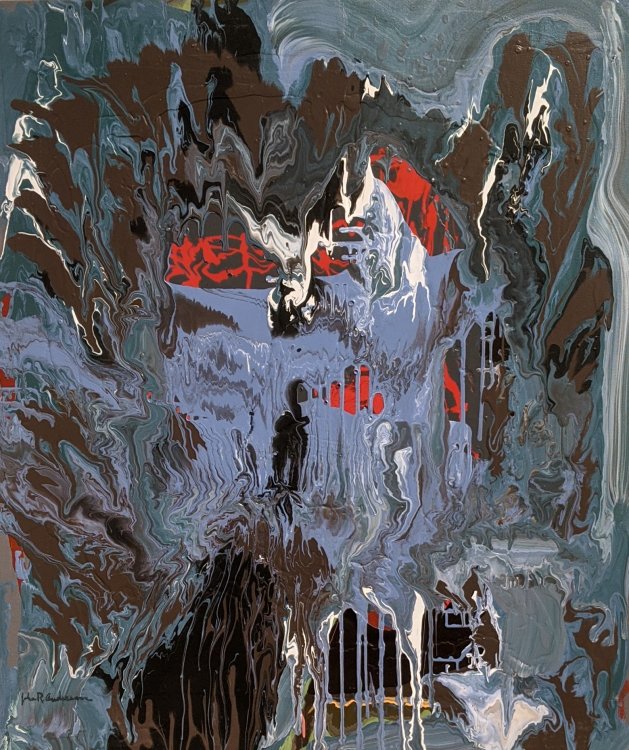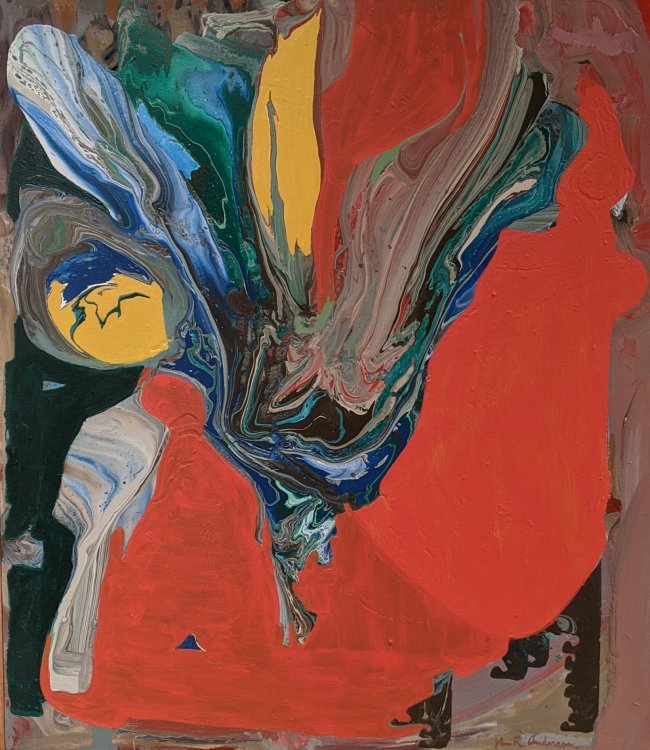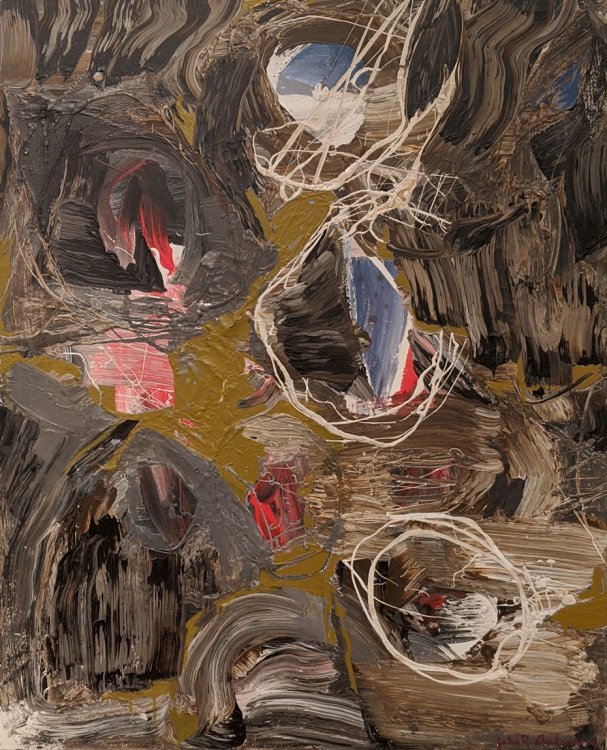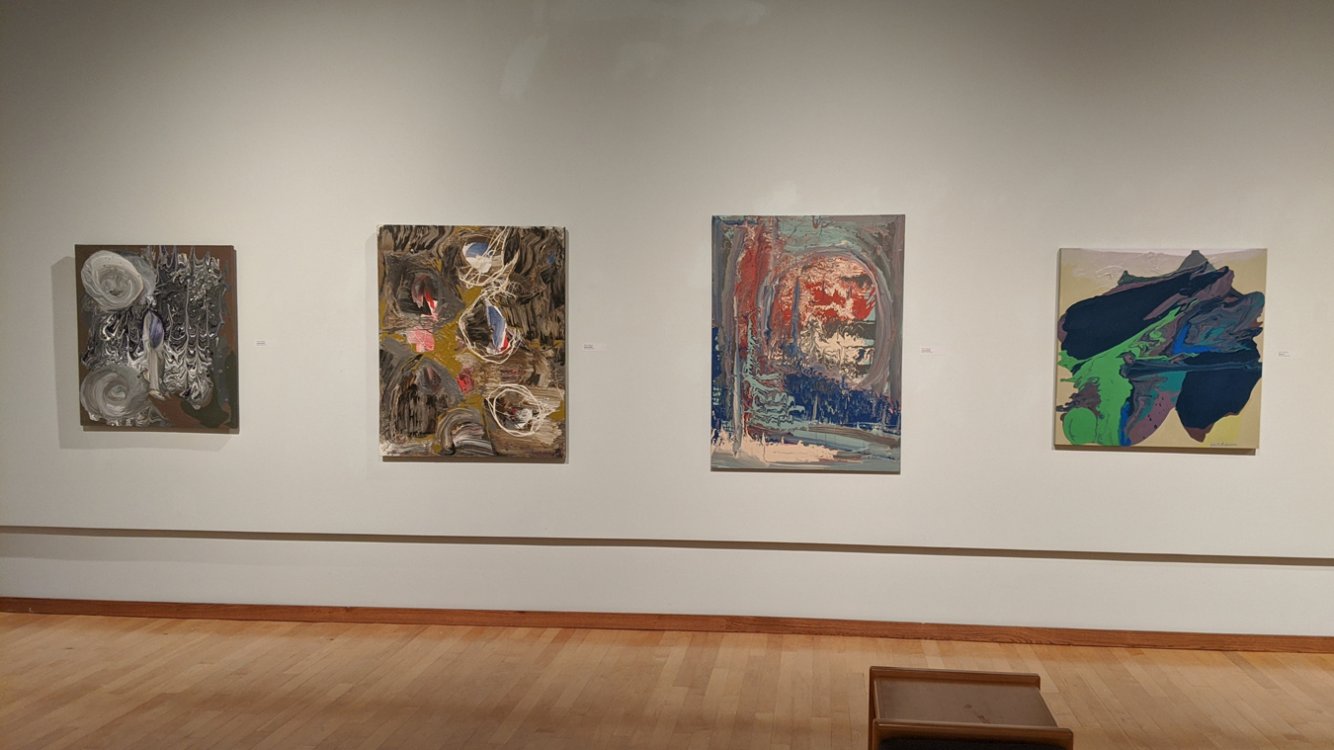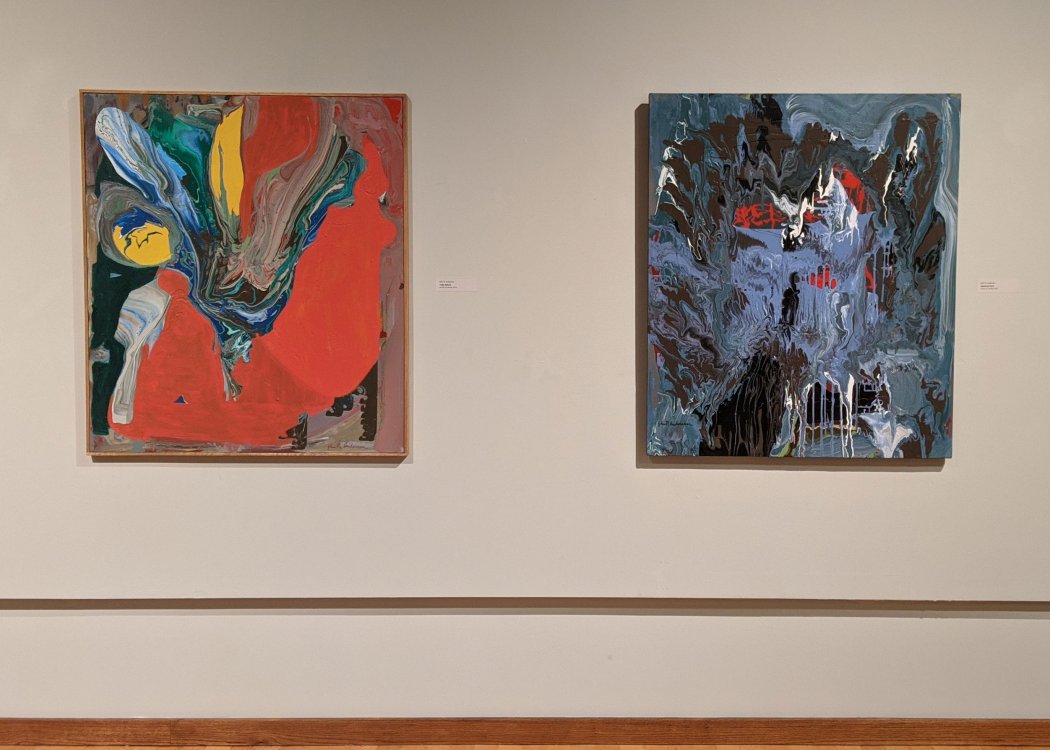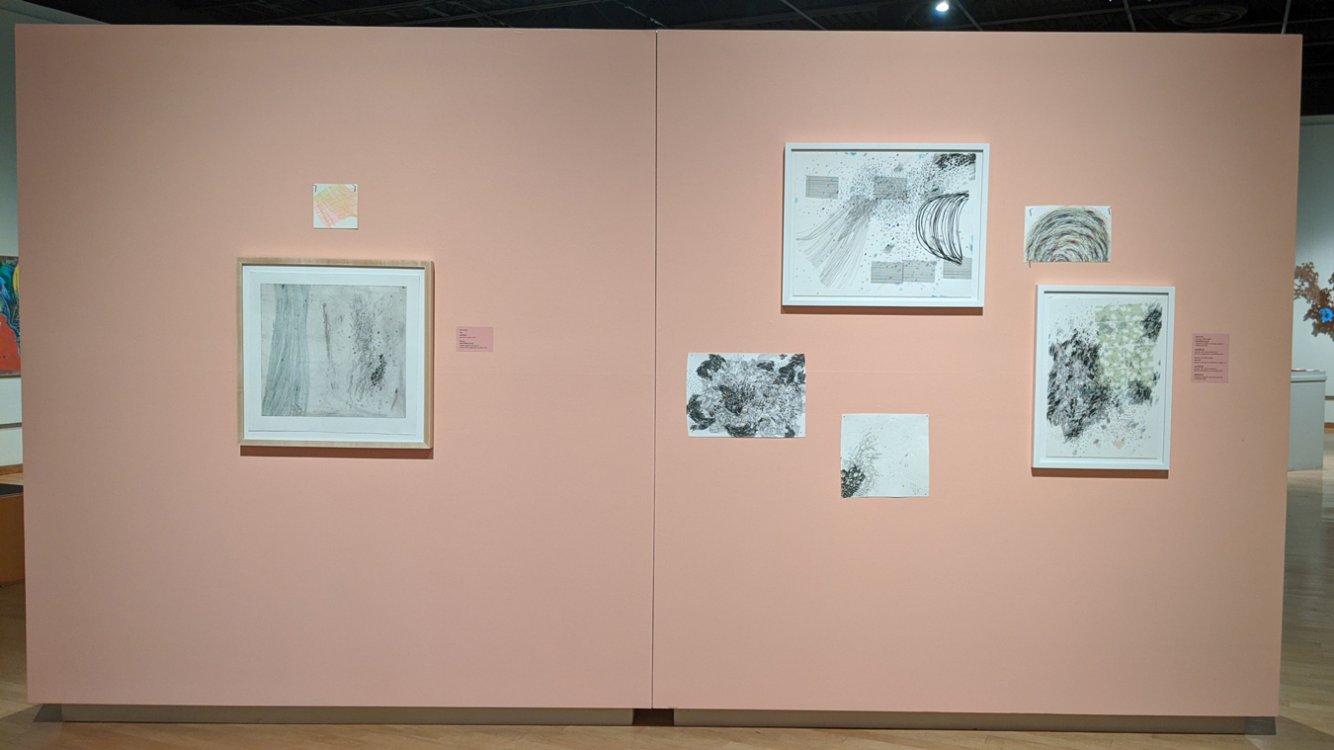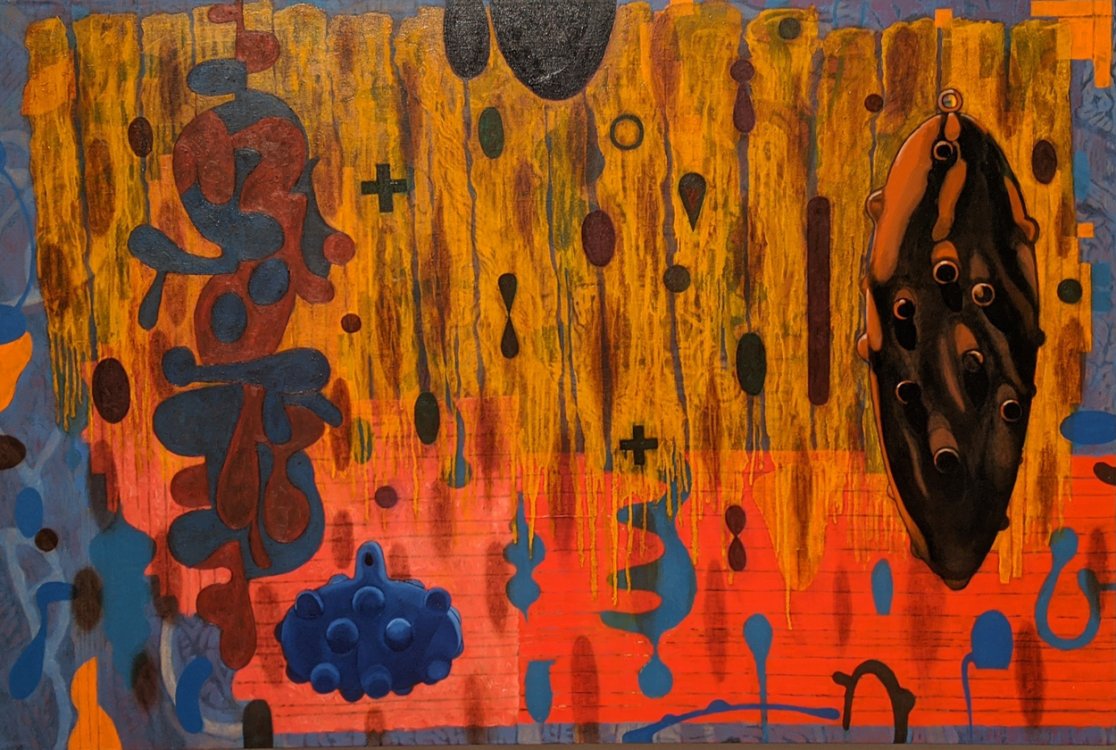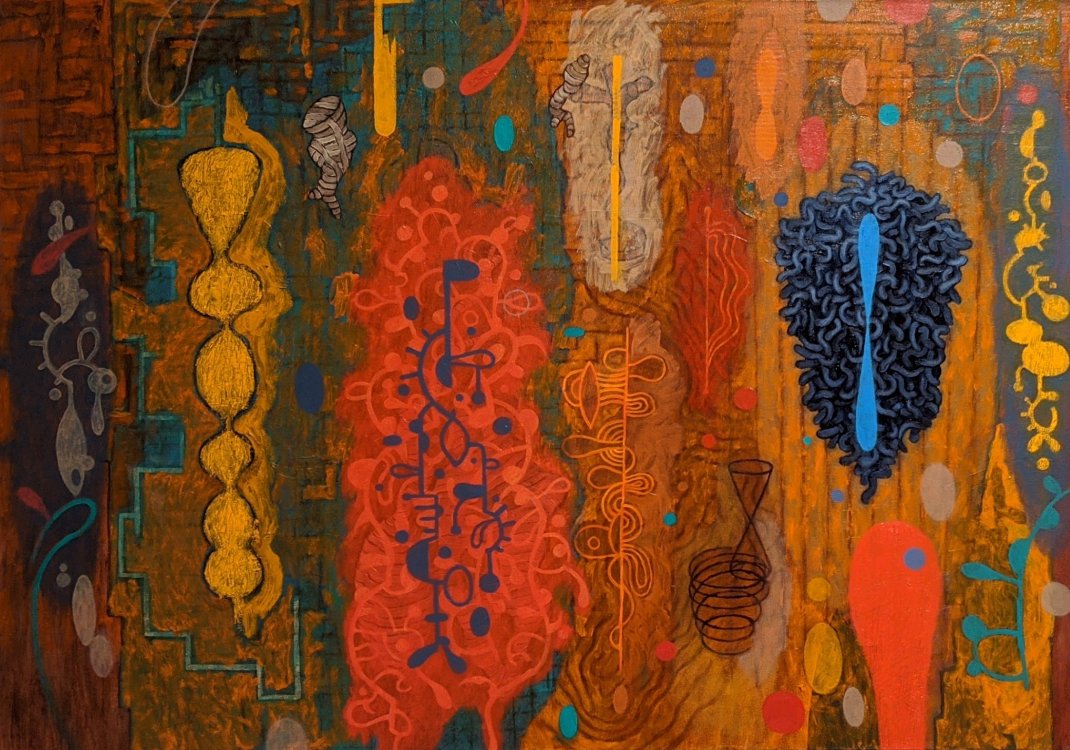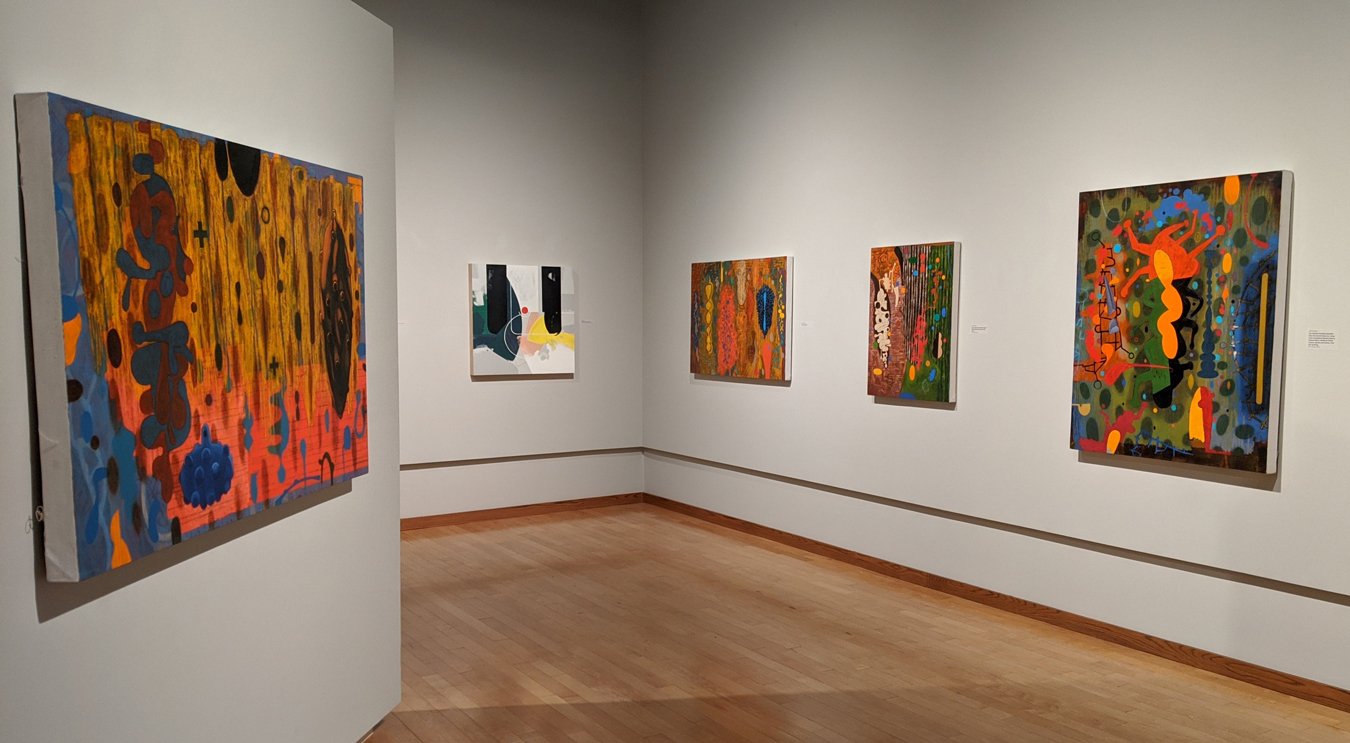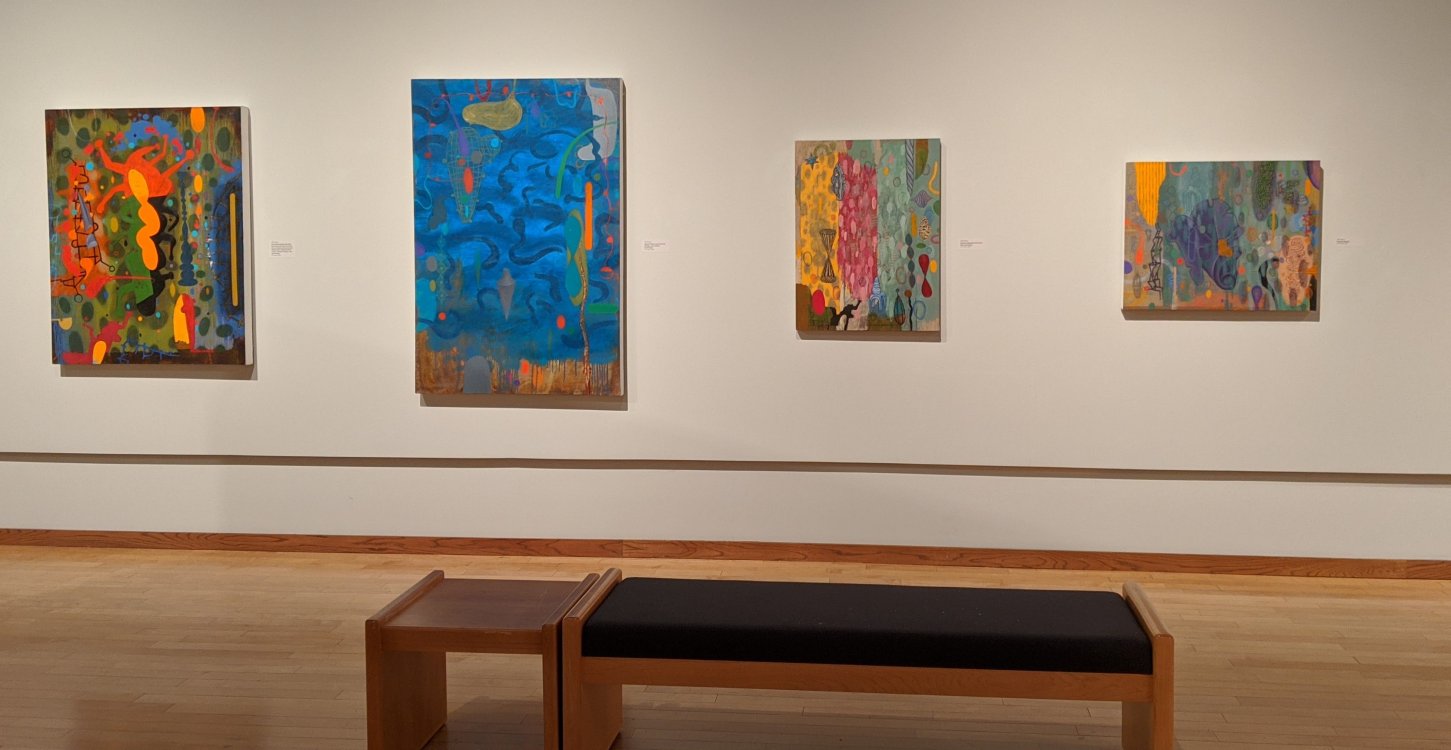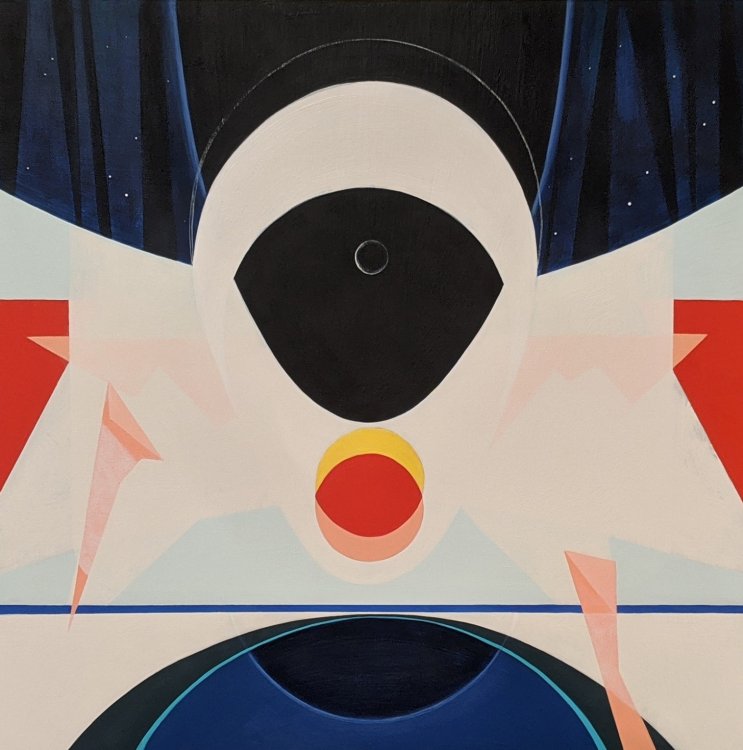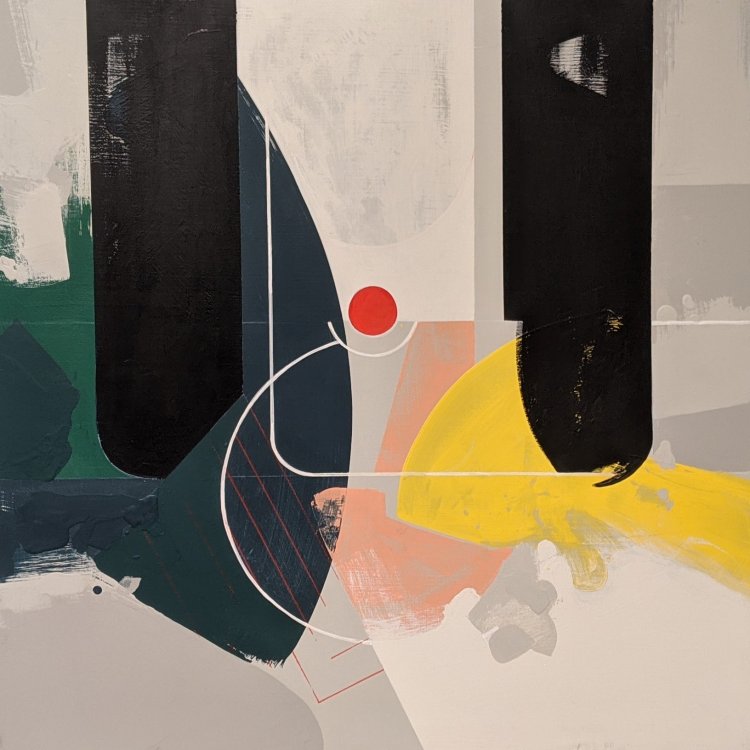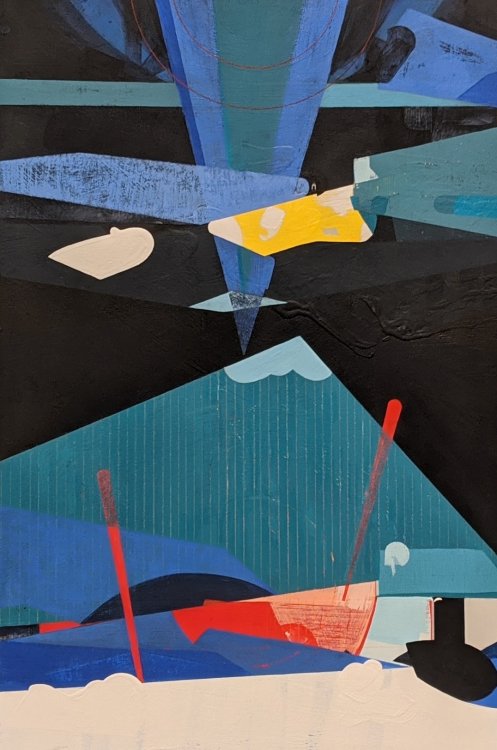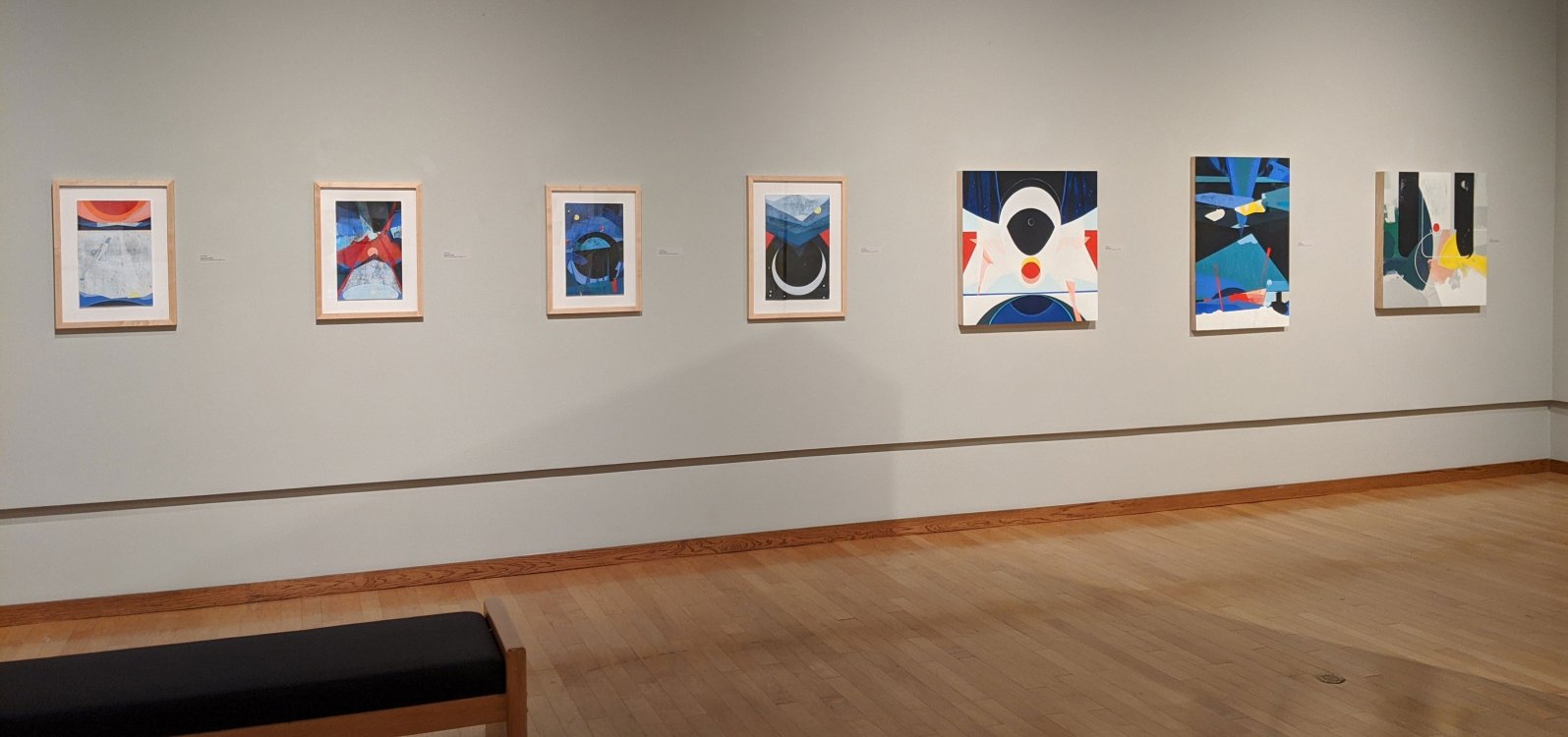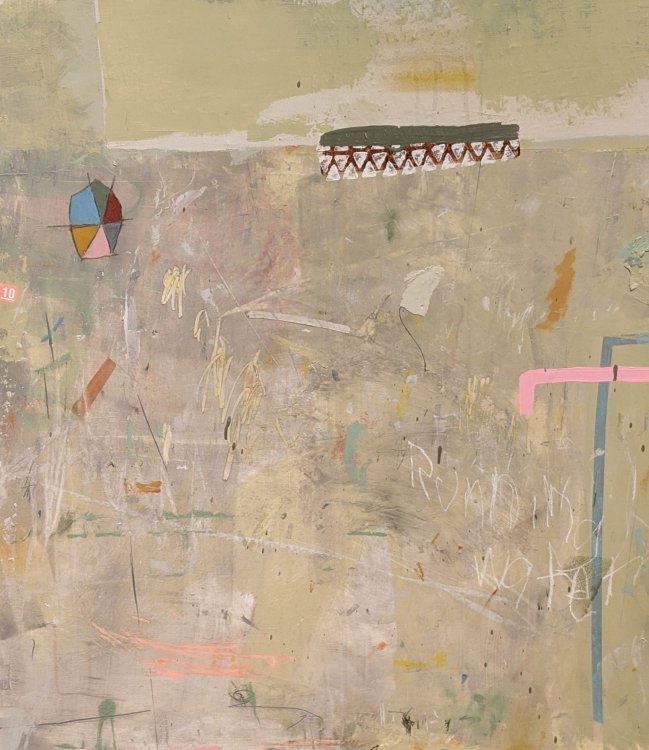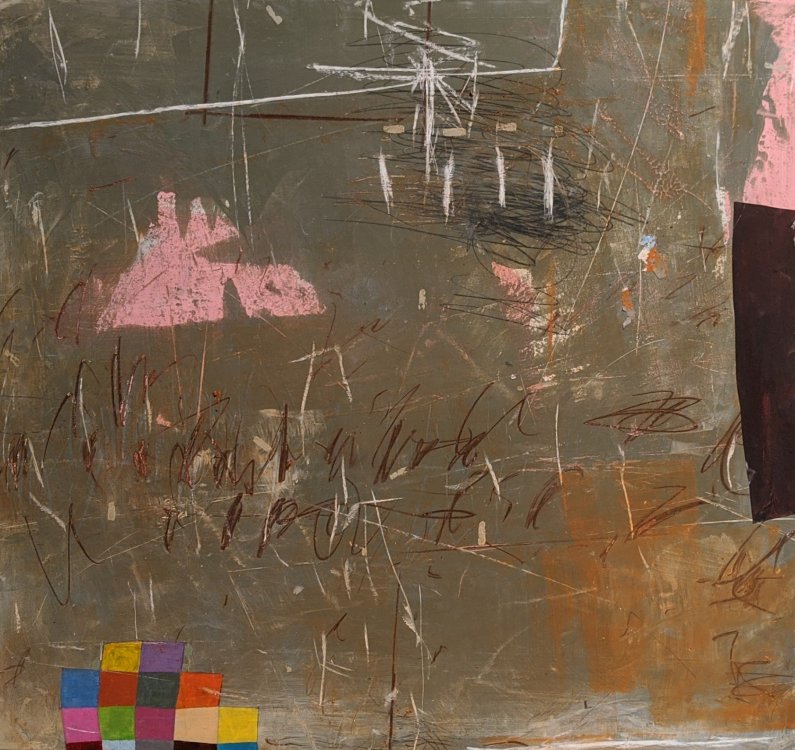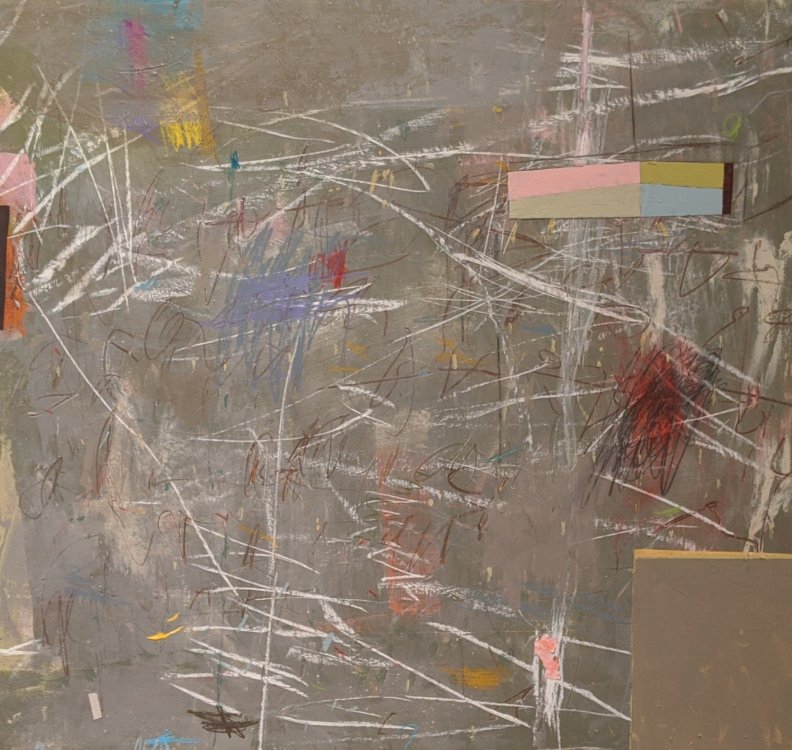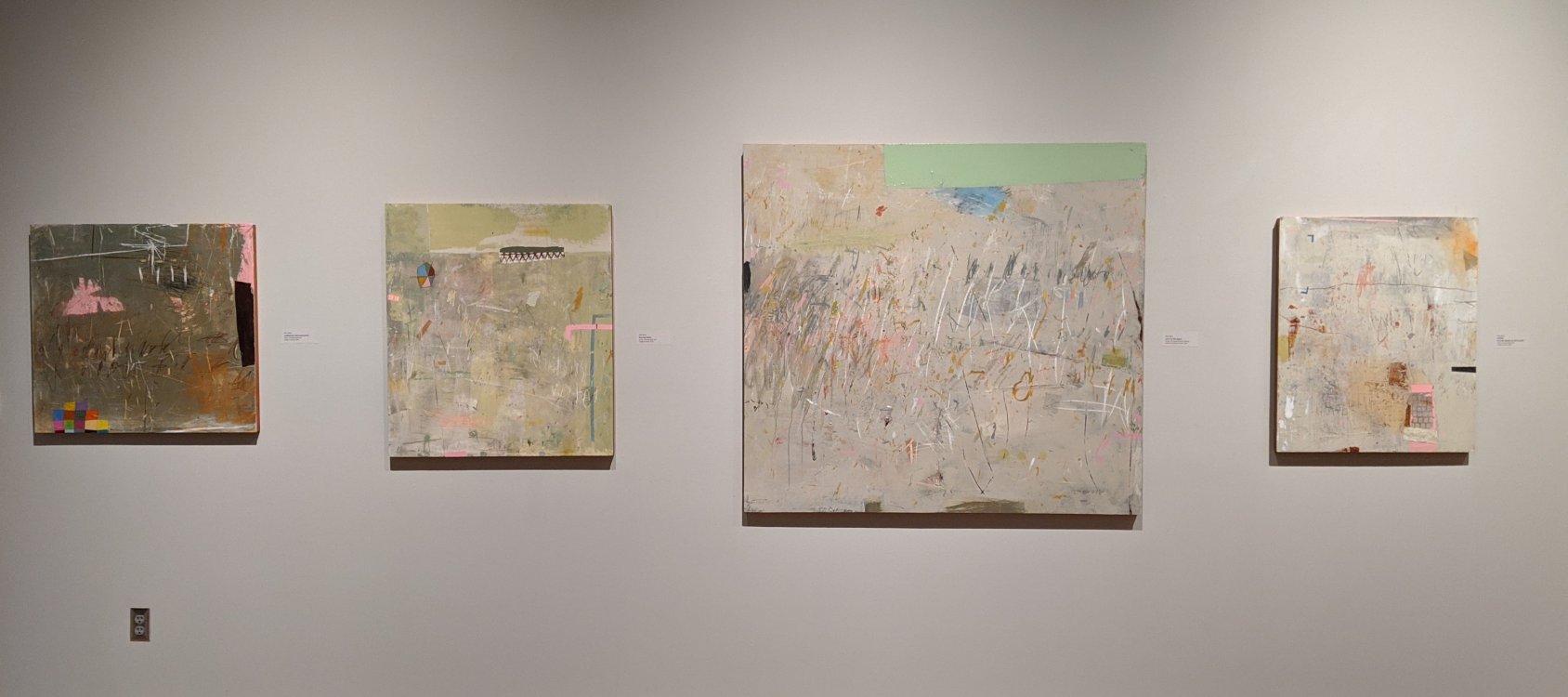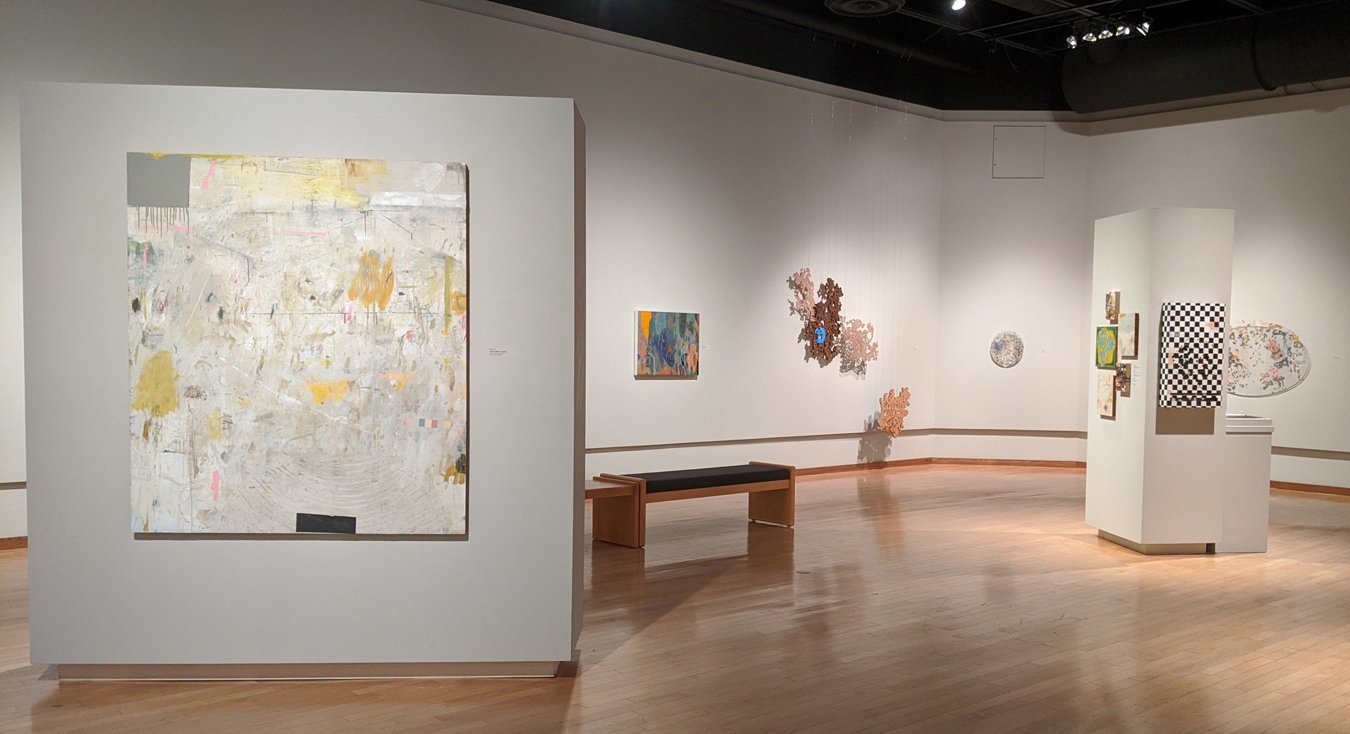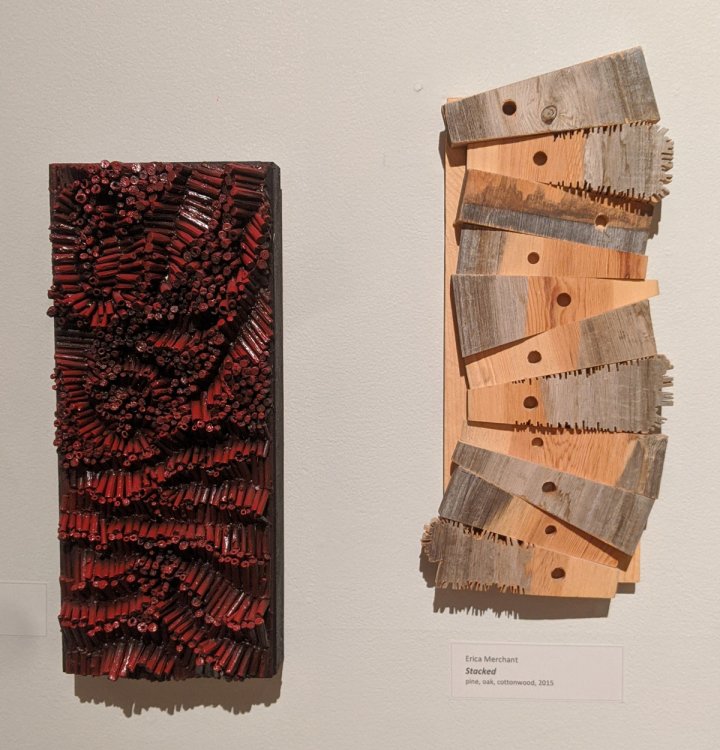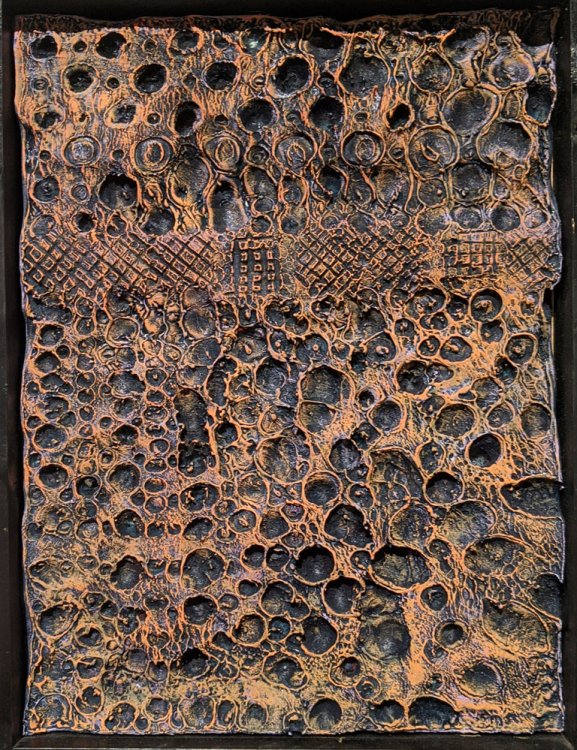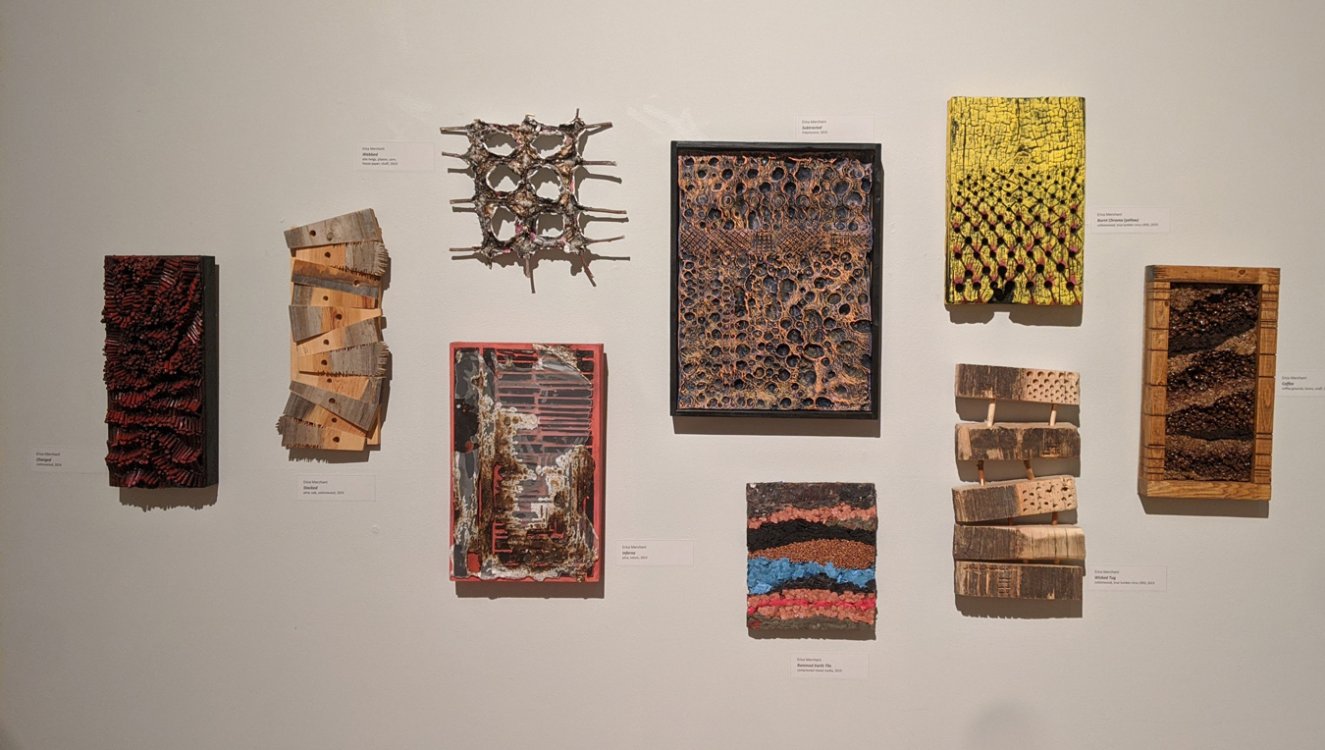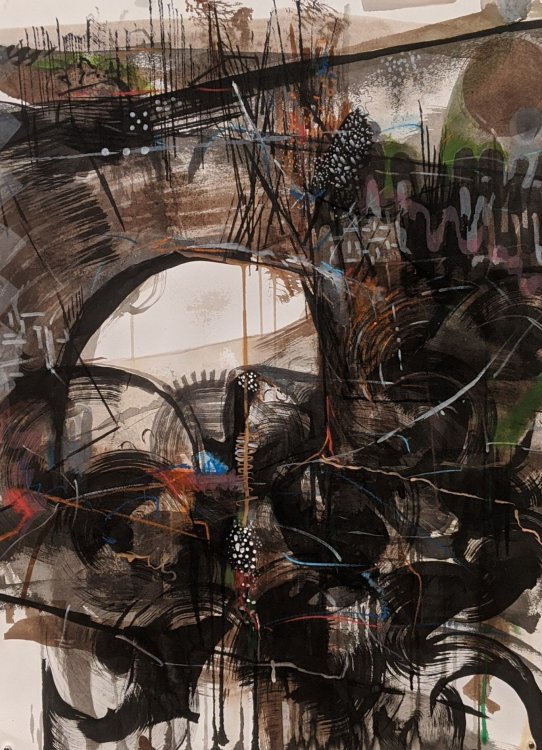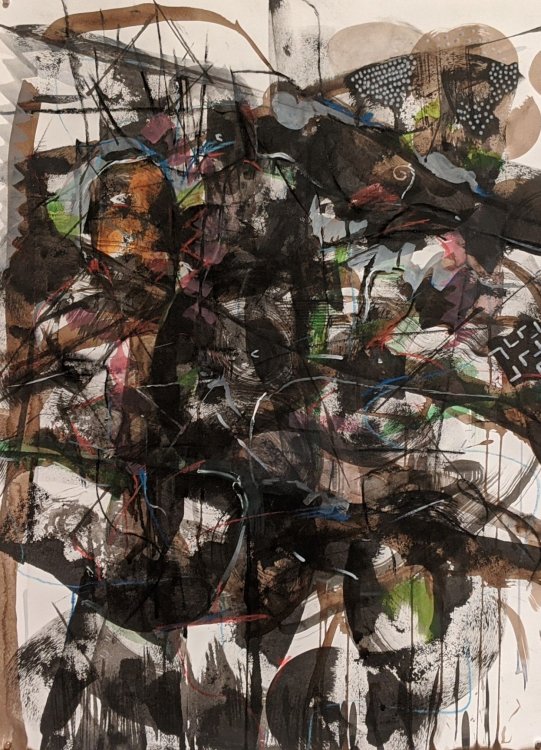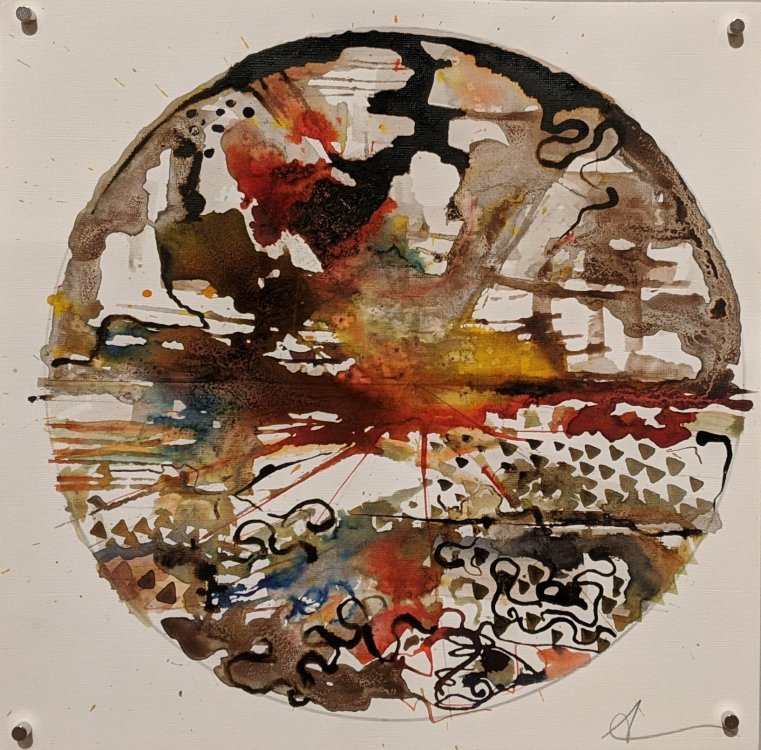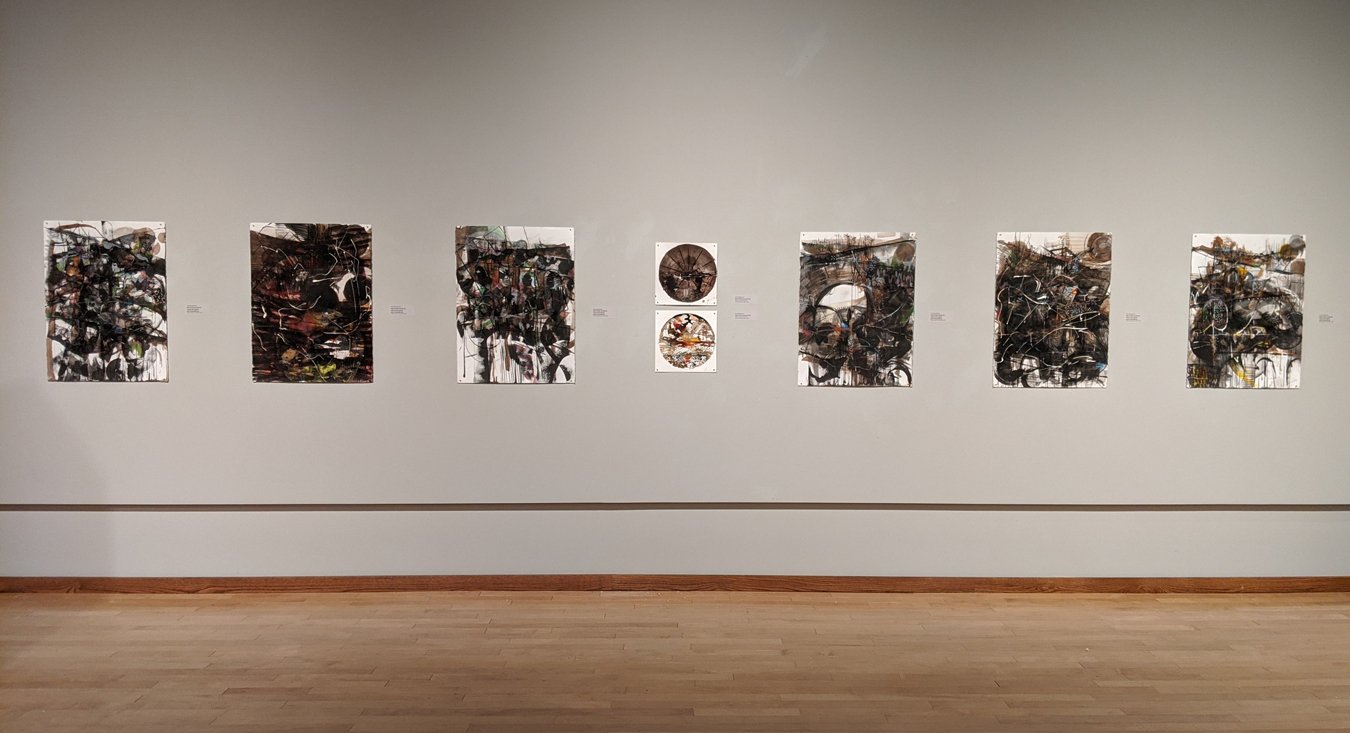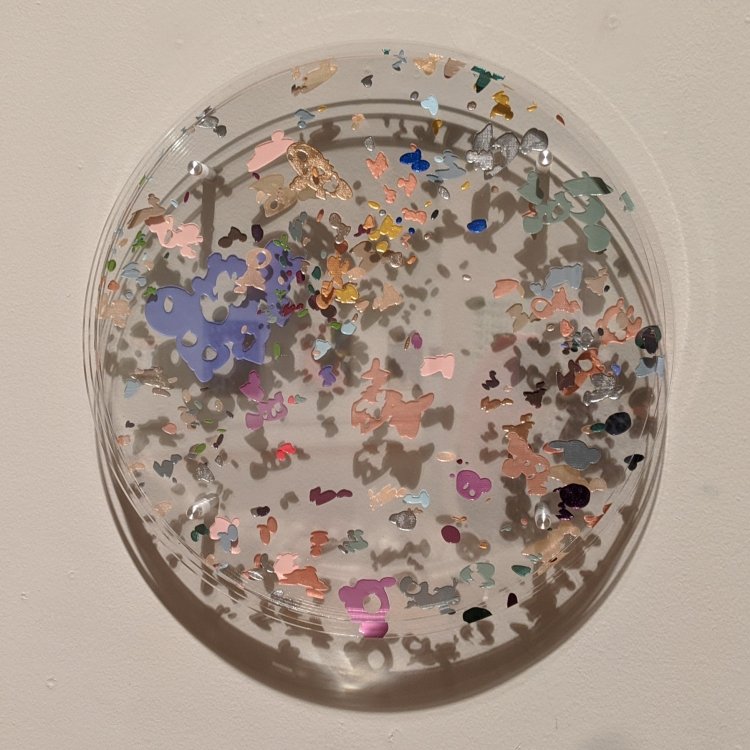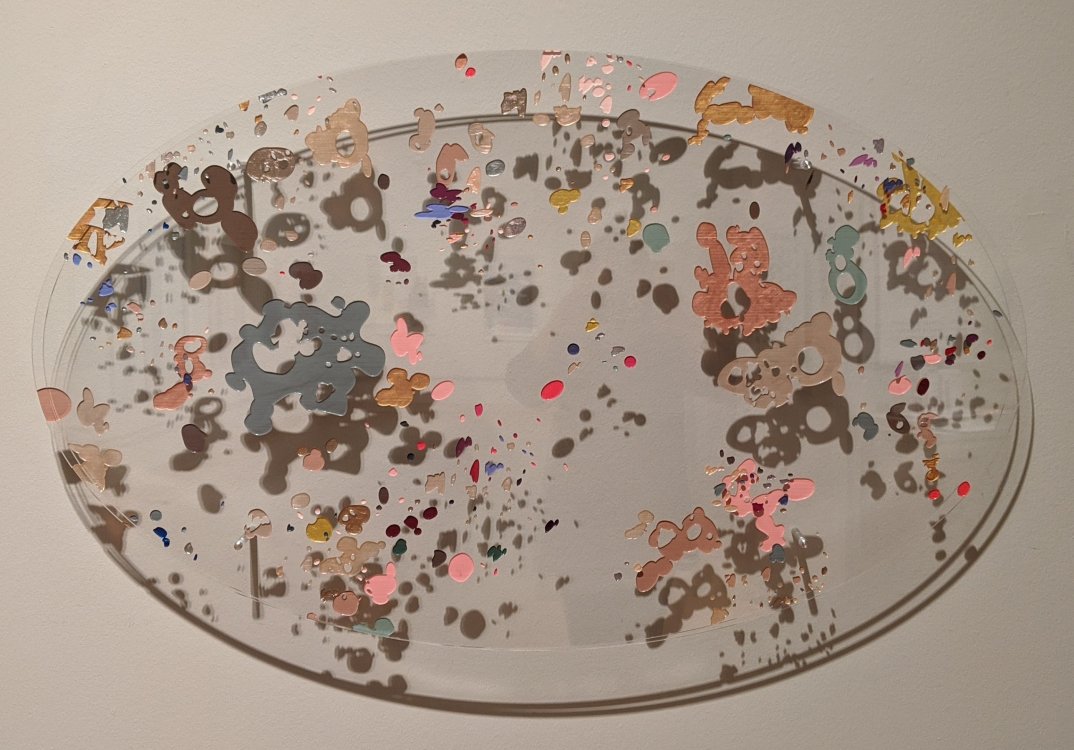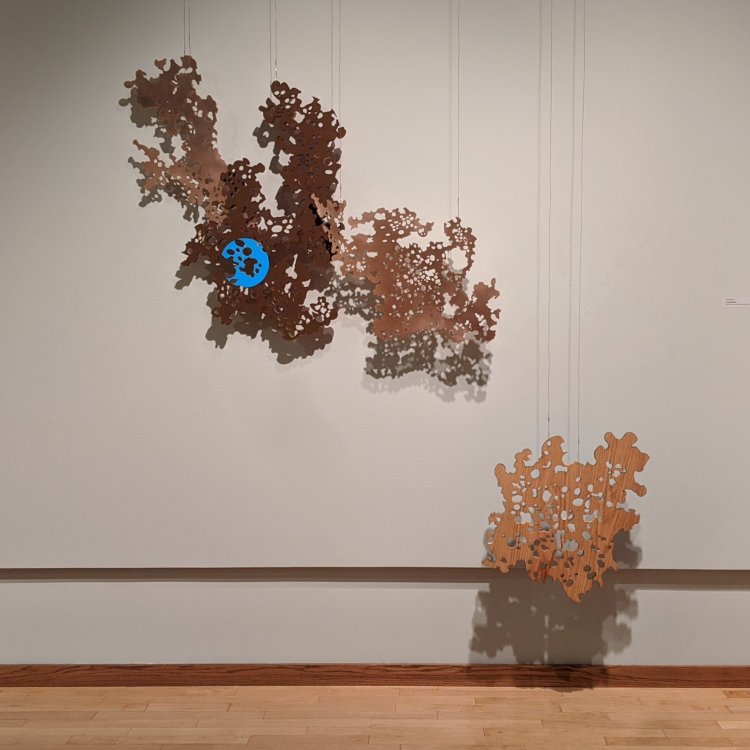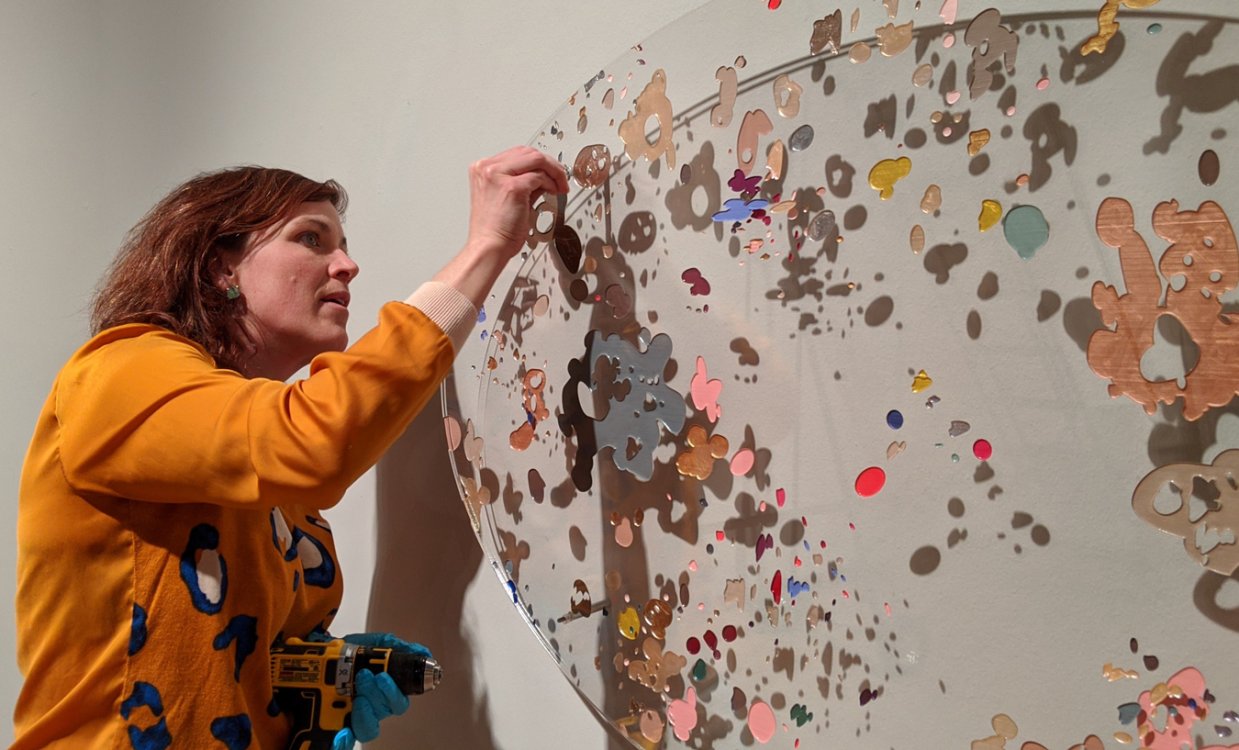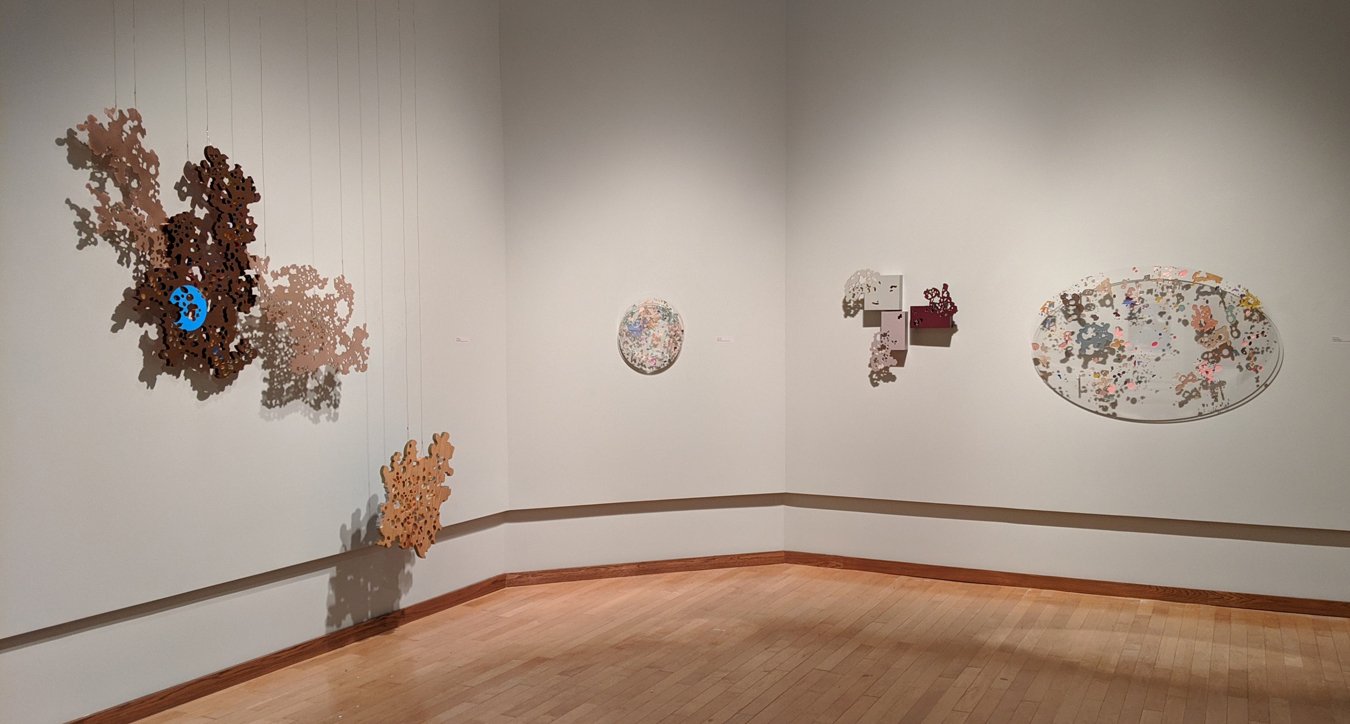
This exhibition celebrates the current practice of non-objective abstraction in South Dakota through the works of eight of the state’s top artists. Artists in the exhibition include John R. Anderson, Diana Behl, Jeff Freeman, Liz Heeren, Rick Johns, Erica Merchant, Alan Montgomery and Molly Wicks.
John R. Anderson was born in Yankton. He studied at the Minneapolis School of Fine Arts (now the Minneapolis College of Art and Design) in Minnesota, under notable instructor Oskar Kokoschka, before earning a BFA from the University of Denver. He traveled and exhibited his works internationally in Mexico and London before returning to Yankton in 1971, where he still paints today.
Anderson’s work is directly tied to the painterly, gestural, lyrical Abstract Expressionism of the 1950s and Process Art of the 1960s. Anderson has tended to create all-over compositions that spread from edge to edge. More recently he’s been creating sparser compositions with dynamic and suspended centers.
Anderson utilizes the accidental effects of paint flow, laying the canvas on the ground and pouring paint, then lifting and rotating the canvas to move the paint in different directions. He then works the paintings upright, responding to the compositional effects of the paint flow by painting out areas in order to accentuate the results that are of most interest to him or “simplify” the complexity of the composition. More recently Anderson has been scraping wide swaths of wet paint away, creating additional layers of visual interest.
These combinations of poured, scraped and brushed layers of paint are a part of a process of call and response, an intuitive and critical engagement with decision-making. Anderson works intuitively in response to process and looks for the right balance between conscious control and instinctual excitement.
Diana Behl is associate professor/program coordinator in the School of Design at South Dakota State University, Brookings. She holds an MFA and M.A. in printmaking from University of Iowa and a BFA in Two-Dimensional and Design Studies from Bowling Green State University. Behl has received grants from the Bush and Griffith Foundations and the South Dakota Arts Council to support her artistic and teaching practices, which are rooted in traditional and expanded printmaking processes and works on paper. She exhibits her works widely and has been featured in New American Paintings, "New Editions" in Art in Print, as well as in artist-run publications such as Maake Magazine and Printeresting's MANUAL.
Artist Statement:
The every day is a central theme within my artistic practice. I engage in processes of inquiry using the language of print media, collage and drawing to examine memory and my quotidian surroundings. Within these surroundings I observe and celebrate the ordinary: moments from my garden and home, passages read, fragments of places visited. I am interested in the work of poet Bernadette Mayer as a mode of interpretation and approach, and current projects use this as a framework through which narratives are shaped or distilled.
My work considers the space between direct and indirect means of image-making. I investigate discords formed in and around the margins of this space: circuitous and lineal, reaction and calculation, clarity and uncertainty. Print media is inherently indirect. A printing matrix is a vessel of sorts, a holding ground for history, action, erasure and the individual quality of your hand. I create images that are transferred onto surfaces—copper, linoleum, Plexiglas—which are then carved, etched, marked and inked. Those surfaces generate an impression, which is further developed and transformed through direct methods of layering, cutting, drawing and distortion.
Jeff Freeman received a B.S. from Minnesota State University-Moorhead, an M.A. from the University of North Dakota in Grand Forks, and an MFA in Painting from the University of Wisconsin-Madison.
He was a professor in the Art Department at the University of South Dakota from 1980 - 2011, teaching Painting on all levels from beginning through the graduate level as well as additional courses in Drawing, Design and Graduate Seminars on Contemporary Art Issues and Criticism. He has been a visiting artist at art schools and universities throughout the United States and overseas. He continues to live in Vermillion, where he makes art, cooks some, reads as much as he has time for, drinks coffee, takes long drives in the country and writes.
Freeman has been the recipient of numerous grants and awards. His work is included in the permanent collections of the Joslyn Art Museum, Omaha, Nebraska; The Sheldon Memorial Gallery of Art, Lincoln, Nebraska; The Plains Art Museum, Fargo, North Dakota; The North Dakota Museum of Art, Grand Forks, North Dakota; The Rourke Gallery and Art Museum, Moorhead, Minnesota; The South Dakota Art Museum, Brookings; The Madison Art Center, Madison, Wisconsin; The Sioux City Art Center, Sioux City, Iowa; and Tianjin Fine Arts Academy, Tianjin, Peoples Republic of China. He has exhibited across the United States and in Canada, Germany and The People’s Republic of China. He is listed in Who’s Who in American Art and Who’s Who in America.
Artist Statement:
For me, Art has to do with truth. The world I find is complex and often not readily visible. Even though my work tends to be somewhat elaborate in its final form, I don’t want it to seem superficial in appearance, as though I was merely dressing it up in some sort of costume. I try to give it some sense of vitality, wanting it to come alive if possible. With regard to those symbolic forms I use, I try to endow them with a sense of energy and passion as I arrive at whatever sense of content the painting may hold. The symbols I find in making the work are important to the sense of content I want, but I don’t try to predetermine what those things mean. More important to me is the relationship of the parts to the whole.
Liz Bashore Heeren earned a B.A. in Biology and Studio Art from Saint Olaf College, an M.A. in Art Theory/Art Education at the University of Arizona, and an MFA in painting at the University of South Dakota in Vermillion. Among other awards, she is the recipient of the University of Arizona’s Creative Achievement award (2000), a Rotary Ambassadorial Scholar (New Zealand, 2001), recipient of the University Center’s Excellence in Teaching Award (2012), and co-recipient of the Sioux Empire Arts Council’s Innovation in the Arts Award (2018). Heeren is currently a full-time professor of Foundations and Painting for the University of South Dakota and director of Ipso Gallery at Fresh Produce, downtown Sioux Falls.
Artist Statement:
I find that there is a harmony developing between me and my child – we are trying to arrive at the same state of mind. It is a state I observe in him; a state that is fluid and natural. It evidences itself as a nexus of fact and fiction seamlessly brought together through his imagination. This state of mind is in synch with my curiosities about the world. We encounter that same zone of flux frequently, in day-to-day life, where we are informed by limited truths. Recently, I’m most interested in the partial truths of science, and the ability of these truths to take us to a partial understanding of ourselves, of our planet and of our universe. This is the zone of abstract and real colliding, leaving us in a partially-informed state. I am often left thinking about what knowledge allows us to grasp, and what is left unanswered by our lack of knowledge.
Many of my recent works explore this – the fact and fiction of life. Lately, this interest has led me to explore cosmic and terrestrial renderings that can be understood, partially, in more than one orientation. My recent landscapes are reversible – so that, in a playful way, I am getting closer to understanding or acceptance of the reverse.
Rick Johns received his BFA and MFA from the University of South Dakota. He is a maker who lives in Vermillion. There he has carved his own path, integrating his interests in art, building, design and woodworking into a way of living with purpose and intent. He is a craftsman/creative that still designs and builds a multitude of projects from custom building and remodeling to site-specific woodworking projects to a straw bale house. This aspect of his life has had the greatest influence on his studio practice. From the manipulation of raw materials to the countless marks, notes, and sketches involved in a building project, to the uncovering and discovery of beauty and history in something that is being dismantled, these are what has most shaped his work. These remnants have value because they have been shaped by time and possess a genuine freshness and honesty. His paintings, as a result, aim to possess similar qualities and elicit an intrinsic sense of wholeness.
Artist Statement:
Oddly, I’m trying to make something that’s real. It just doesn’t look like anything familiar. My works are exactly what you see, made up of paint, drawing media and other material. Combined, I’m trying to make something that draws you in because you sense something of value in what you see. Painting is a practice where I can create something never before seen. Through exploration and discovery works evolve through trial and error. Not knowing the endgame, that adventure is an exciting and sometimes frustrating challenge. As the paintings develop, I find value in the insignificant and unintended marks and gestures. Alone they are nothing, but together in a context they become meaningful, something with purpose. They are part of a history and a larger whole that exists in a fluid balance. Each painting creates a world within itself that talks about process, time, randomness and the delicate order and balance in which it exists.
Erica Merchant lives in Rapid City with her daughter McKenzie, a senior in high school this year. Erica received her bachelor's degrees in Anthropology and Humanities from the University of Wyoming and her Master of Fine Arts, emphasis Sculpture, from the University of South Dakota. Erica is a 2014 recipient of the South Dakota Arts Council Emerging Artist Grant.
Artist Statement:
The inspiration for my work is grounded in our geological history. More specifically, layers of earth define our past and, much like memories, what remains is accidental, not on purpose.
I find the action of accidental preservation of certain objects to be one of the most beautiful and simultaneously the most saddening experiences. The beauty of sediment layers today belies the chaos and destruction that took place in the past to create them. My work employs tension, compression and metamorphic processes. Just as geological remnants are discovered, past memories intrude our present thoughts to evoke a nostalgic and pleasing narrative. Intruding memories from the past causes raw emotion, the deep history at a personal, historical and geological level, May be preserved or lost; what remains is unintentional. The past that sticks around is not on purpose; past memories do not make themselves remain in the strata of our minds, nor does a fossil determine its fate. The serendipity of placement in time and space is the only determining factor as to whether something survives to be discovered. I like to think of our memories as a fossilized narrative.
Alan Montgomery was born in Belfast, Northern Ireland, and currently resides in Madison, where he is a professor of Art at Dakota State University. He received a BFA from Minnesota State University-Mankato and an MFA from the University of Nebraska-Lincoln. His work is exhibited in Europe and the United States, and has been published in "A World of Art," an art appreciation text by Henry M. Sayre, 7th and 8th editions, published by Pearson Higher Education. In the summer of 2019, he was an artist-in-residence at the Lucid Art Foundation, Inverness, California. His other interests include beekeeping, cycling and traveling.
Artist Statement:
The inspiration for the Bog Cycle series began back in 1994 in graduate school, reading the late Irish poet Seamus Heaney. Heaney’s seminal pieces on the Irish peat bog is a journey through time and space and a signifier of the Irish culture. I spent the early part of my life in Belfast, Northern Ireland, during the period known as the troubles. Heaney wrote a number of bog poems during this time and they reflect that period, but they also answer to the metaphysical, the ancient and the richness of the Irish language and landscape. The patterns and rhythm of Heaney’s writing struck a chord in me. I see something in the writing that is profound and immense. I am not illustrating his poems, but rather I am interpreting the written text through the visual language of design and art in an effort to better understand how meaning occurs in my own work and how I can move forward with the Bog Cycle series.
For me a work of art is a process that should be visible in the final work. That process is a series of formal decisions that accumulate over the duration of time spent on one or more pieces in the studio. As an artist, my yielding to the qualities of a particular set of variables is tempered by my search for unity and gestalt. I begin with my materials. The medium begins a dialog. In the Bog Cycle work I choose ink because it is a fluid medium, which behaves in ways that are both unexpected and predictable. I believe the inherent qualities of ink and paint are thus flexible enough for experiment as well as for precise control. I use Oak and Walnut inks for their earthy tones and their cosmic connection to ancient Irish cultures who regarded oak groves as sacred places.
Molly Wicks received her MFA from Washington State University and her BFA at the University of Minnesota. She is a Lecturer / Common Core Coordinator for the School of Design at South Dakota State University. Wicks has been featured in the Western Edition of "New American Paintings" (Volume 102) and in the online gallery Artist a Day. Her most recent large endeavor and success was the commissioned piece hanging in the atrium of Harding Hall here on campus, "connect. Interweave. evolve." Her work has been included in solo shows at the Sarasota Center for Art, Florida; the Johnson Fine Arts Center at Northern State University, Aberdeen; and the Shoebox Gallery, Minneapolis. She has been included in group shows at the Washington Pavilion in Sioux Falls; Manifest Gallery, Cincinnati, Ohio; Saranac Art Projects, Spokane, Washington; the McCormick Gallery, Midland, Texas and Rosalux Gallery in Northeast Minneapolis. Beyond Molly’s love of spending time in the studio and in the classroom, she loves to travel, ski, go to concerts, cook and to have fun with her two lovely daughters, handsome boyfriend, friends and extended family.
Artist Statement:
I look at maps of lakes or islands, I look at visuals of sedimentary layers and I love looking at images of fungi and mold. In reaction to this looking, I work into a panel in a subtractive fashion. I do this by drawing in Illustrator and Rhino and then having my medium cut by way of water-jet or laser. I am interested in how my subtractive cutouts create shadows, and how those shadows relate to reflected colors on the wall. I thoughtfully use colors that are chosen to compliment the shapes and materials used. I am also interested in how the color painted within any cutout relate to the cast shadows inherently created.
Credits
Exhibit image on our home page: Jeff Freeman, Pentecostal Aria with Bipolar Pas de Deux (detail), oil on canvas, 2020


